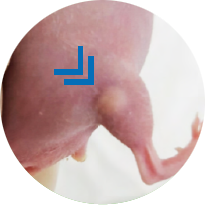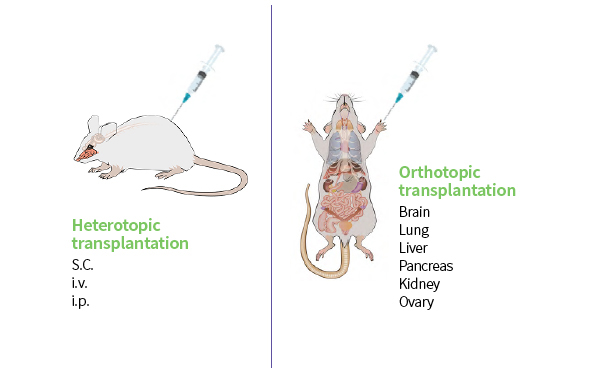Service
Custom Mouse Model Generation
Tumor Xenograft Mouse Model
We establish various xenograft models using either cell lines or patient-derived tissues to analyze tumor growth, metastasis, and drug response.
Customizable Tumor Xenograft Mouse Models
-
Xenograft Model
- Cell line derived(CDX)
- Patient tissue-derived(PDX)
-
Orthotopic Model
- Mammary gland
- Liver
- Spleen
- Pancrease
- Brain etc.
-
Metastasis Model
- Tail Vein, Jugular vein : lung & systemic metastasis
- Mammary gland: Lung
- Splenic, Portal vein : Liver
- Intra-heart: Bone & systemic metastasis
Analysis Items
Body weight and tumor size measurement, Tumor imaging analysis, Hematoxylin and Eosin (H&E) staining, Immunohistochemistry (IHC) staining
Service Process
-
1
Model selection and establishment
-
2
Drug administration and anti-tumor response monitoring
-
3
Immune cell analysis
-
4
Histological analysis and pathological evaluation
-
5
Data analysis and report delivery
CDX (Cell Line-Derived Xenograft) Mouse Model
-
Subcutaneous Tumor Implantation
-
Intramuscular Tumor Implantation
-
Metastatic models liver, lung, bone, brain
-
Orthotopic models brain, lung, breast, tongue etc.

Implantation of human-derived cancer cells into the subcutaneous tissue of nude mice
- Various tumor xenograft models can be established using cancer cell lines to evaluate the efficacy of therapeutic agents.
- In metastatic tumor models, imaging-based tumor assessment is possible using MRI, CT, or IVIS.
- Tumor response following radiation exposure can be assessed in all xenograft models.
PDX mouse model
Patient-derived tumor tissues with characterized genetic information are implanted into immunodeficient mice for screening of cytotoxic and targeted anticancer agents.


